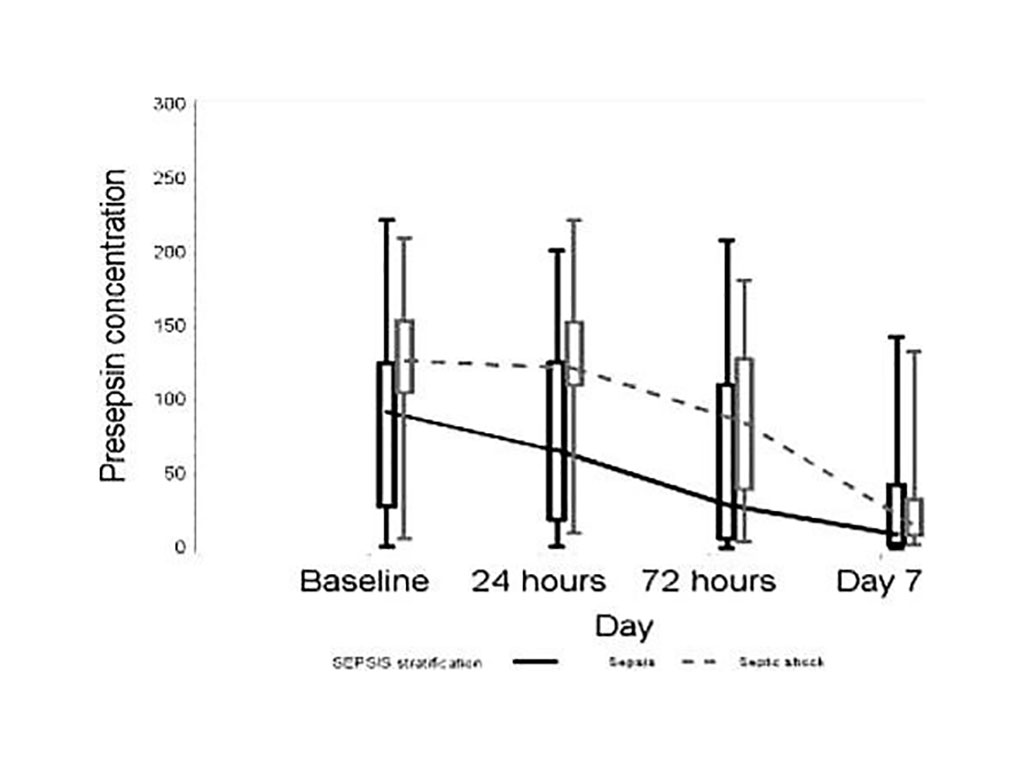Presepsin Values Evaluated as Sepsis Severity Markers
By LabMedica International staff writers
Posted on 23 Jun 2020
Sepsis is a life-threatening condition, with poor and highly variable clinical manifestations, difficult to identify and diagnose. Sepsis has remained a real diagnostic challenge to clinicians, causing millions of death worldwide each year. Early recognition of sepsis is crucial for better disease outcome.Posted on 23 Jun 2020
Blood cultures are a gold standard for diagnosing sepsis. Despite the great advantages, blood cultures also have some limitations as they are often negative, especially in patients previously treated with antibiotic, and their results are usually obtained over several days. While waiting for blood culture results, treatment of critically ill septic patients may be delayed, increasing the possibility of poor outcome.

Image: Presepsin concentrations (ng/mL) in two severity groups. Black line: sepsis patients; black dotted line: septic shock patients (Photo courtesy of University Hospital for Infectious Diseases in Zagreb).
Infectious disease specialist at the University Hospital for Infectious Diseases (Zagreb, Croatia) and their colleagues conducted a prospective observational study in two university clinical centers and enrolled 100 septic patients during two time periods. New Sepsis-3 definitions were used for sepsis stratification. Biomarkers and SOFA score were evaluated four times during the illness.
Routine laboratory parameters and C-reactive protein (CRP) were tested immediately. For procalcitonin (PCT) and presepsin levels measurements, blood was collected at all four time points, frozen until the end of the study, and then measured. Quantitative analysis of PCT was performed using an automated electrochemiluminescence immunoanalyzer (ELECSYS* BRAHMS* PCT; Roche Diagnostics, Mannheim, Germany). A sandwich enzyme-linked immune-sorbent assay ̶ Human Presepsin ELISA Kit (Nordic Biosite, Täby, Sweden), was used for presepsin measurement.
The following laboratory parameters were recorded: red blood cell count, hemoglobin, hematocrit, white blood cell count, platelet count, serum creatinine, serum total bilirubin, serum liver enzymes (aspartate aminotransferase-AST and alanine aminotransferase-ALT), partial thromboplastin time (PTT), international normalized ratio (INR), electrolytes (sodium and potassium), blood gas analysis, CRP, PCT, and presepsin concentrations.
The scientists reported that presepsin concentrations were significantly higher on admission in 34 patients with septic shock compared to 66 patients with sepsis, mean ± SD: 128.5 ± 47.6 ng/mL versus 88.6 ± 65.6 ng/mL, respectively. The same was not observed for PCT and CRP; their concentrations did not differ significantly between severity groups. A strong correlation of presepsin with SOFA score was also found.
The authors concluded that their study showed that serum presepsin concentration on admission reflects the severity of disease. Presepsin was a better predictor of multiple organ dysfunction syndrome compared to other tested sepsis biomarkers. The strong correlation of presepsin with SOFA score makes this marker a valuable tool for identifying septic patients. PCT and CRP concentrations did not differ between sepsis severity groups. The study was published in the June, 2020 issue of the International Journal of Infectious Diseases.









 assay.jpg)



